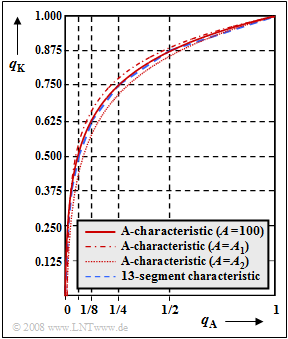Exercise 4.6: Quantization Characteristics
From LNTwww
Non-linear quantization is considered. The system model according to Exercise 4.5 still applies.
The graph shows two compressor characteristics qK(qA):
- Drawn in red is the so-called "A-characteristic" recommended by the CCITT ("Comité Consultatif International Téléphonique et Télégraphique") for the standard system PCM 30/32. For 0≤qA≤1 applies here:
- qK(qA)={1+ln(A⋅qA)1+ln(A)A⋅qA1+ln(A)1/A≤qA≤1,qA<1/A.
- The blue-dashed curve applies to the so-called "13-segment characteristic". This is obtained from the A-characteristic by piecewise linearization; it is treated in detail in the Exercise 4.5 .
Hints:
- The Exercise belongs to the chapter "Pulse Code Modulation".
- Reference is made in particular to the page "Compression and Expansion".
- For the A-characteristic drawn in solid red, the quantization parameter A=100 is chosen. With the value A=87.56 suggested by CCITT, a similar curve is obtained.
- For the other two curves,
- A=A1 (dash–dotted curve) and
- A=A2 (dotted curve),
where for A1 and A2 the two possible numerical values 50 and 200 are given. In the subtask (3) you are to decide which curve belongs to which numerical value.
Questions
Solution
(1) Correct are the statements 2 and 3:
- Signal distortion of soft sounds or in speech pauses is subjectively perceived as more disturbing than e.g. additional noise in heavy metal.
- In terms of quantization noise or SNR, however, there is no improvement due to non-linear quantization if an uniformly distribution of the amplitude values is assumed.
- However, if one considers that in speech and music signals smaller amplitudes occur much more frequently than large ⇒ "Laplace distribution", non-linear quantization also results in a better SNR.
(2) Correct are the statements 1 and 2:
- Due to the linearization in the individual segments, the interval width of the various quantization levels is constant in these for the "13-segment characteristic", which has a favorable effect in realization.
- In contrast, with the non-linear quantization according to the "A-characteristic", there are no quantization intervals of equal width.
This means: The statement 3 is false.
(3) Correct is "NO":
- For qA=1 one obtains independently of A the value qK=1.
- So with this specification alone A cannot be determined.
(4) Correct is again "NO":
- For qA=1/A both range equations yield the same value qK=1/[1+ln(A)].
- Also with this A cannot be determined.
(5) With this requirement A is now computable:
- 0.875=1+ln(A/2)1+ln(A)=1−ln(2)+ln(A)1+ln(A)≈1−0.693+ln(A)1+ln(A)⇒ln(A)=0.875−0.3071−0.875=4.544⇒A≈94_.
(6) Correct is statement 2:
- The curve for A1=200 lies above the curve with A=100, the curve with A2=50 below.
- This is shown by the following calculation for qA=0.5:
- A=100:qK=1+ln(100)−ln(2)1+ln(100)=1+4.605−0.6931+4.605≈0.876,
- A=200:qK=1+5.298−0.6931+5.298≈0.890,
- A=50:qK=1+3.912−0.6931+3.912≈0.859.
